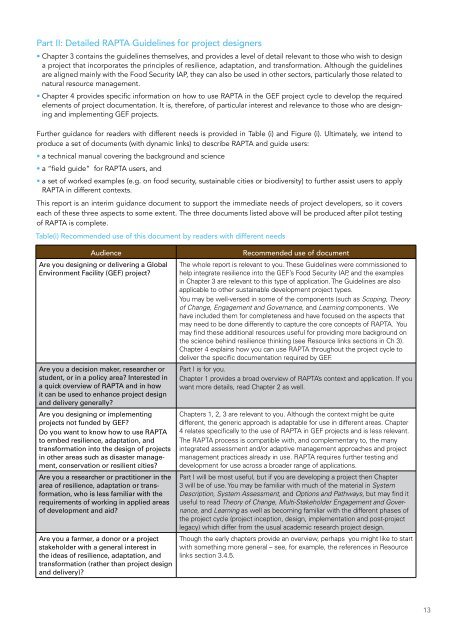DESIGNING PROJECTS IN A RAPIDLY CHANGING WORLD
srun3013fp1
srun3013fp1
You also want an ePaper? Increase the reach of your titles
YUMPU automatically turns print PDFs into web optimized ePapers that Google loves.
Part II: Detailed RAPTA Guidelines for project designers<br />
• Chapter 3 contains the guidelines themselves, and provides a level of detail relevant to those who wish to design<br />
a project that incorporates the principles of resilience, adaptation, and transformation. Although the guidelines<br />
are aligned mainly with the Food Security IAP, they can also be used in other sectors, particularly those related to<br />
natural resource management.<br />
• Chapter 4 provides specific information on how to use RAPTA in the GEF project cycle to develop the required<br />
elements of project documentation. It is, therefore, of particular interest and relevance to those who are designing<br />
and implementing GEF projects.<br />
Further guidance for readers with different needs is provided in Table (i) and Figure (i). Ultimately, we intend to<br />
produce a set of documents (with dynamic links) to describe RAPTA and guide users:<br />
• a technical manual covering the background and science<br />
• a “field guide” for RAPTA users, and<br />
• a set of worked examples (e.g. on food security, sustainable cities or biodiversity) to further assist users to apply<br />
RAPTA in different contexts.<br />
This report is an interim guidance document to support the immediate needs of project developers, so it covers<br />
each of these three aspects to some extent. The three documents listed above will be produced after pilot testing<br />
of RAPTA is complete.<br />
Table(i) Recommended use of this document by readers with different needs<br />
Audience<br />
Are you designing or delivering a Global<br />
Environment Facility (GEF) project?<br />
Are you a decision maker, researcher or<br />
student, or in a policy area? Interested in<br />
a quick overview of RAPTA and in how<br />
it can be used to enhance project design<br />
and delivery generally?<br />
Are you designing or implementing<br />
projects not funded by GEF?<br />
Do you want to know how to use RAPTA<br />
to embed resilience, adaptation, and<br />
transformation into the design of projects<br />
in other areas such as disaster management,<br />
conservation or resilient cities?<br />
Are you a researcher or practitioner in the<br />
area of resilience, adaptation or transformation,<br />
who is less familiar with the<br />
requirements of working in applied areas<br />
of development and aid?<br />
Are you a farmer, a donor or a project<br />
stakeholder with a general interest in<br />
the ideas of resilience, adaptation, and<br />
transformation (rather than project design<br />
and delivery)?<br />
Recommended use of document<br />
The whole report is relevant to you. These Guidelines were commissioned to<br />
help integrate resilience into the GEF’s Food Security IAP, and the examples<br />
in Chapter 3 are relevant to this type of application. The Guidelines are also<br />
applicable to other sustainable development project types.<br />
You may be well-versed in some of the components (such as Scoping, Theory<br />
of Change, Engagement and Governance, and Learning components. We<br />
have included them for completeness and have focused on the aspects that<br />
may need to be done differently to capture the core concepts of RAPTA. You<br />
may find these additional resources useful for providing more background on<br />
the science behind resilience thinking (see Resource links sections in Ch 3).<br />
Chapter 4 explains how you can use RAPTA throughout the project cycle to<br />
deliver the specific documentation required by GEF.<br />
Part I is for you.<br />
Chapter 1 provides a broad overview of RAPTA’s context and application. If you<br />
want more details, read Chapter 2 as well.<br />
Chapters 1, 2, 3 are relevant to you. Although the context might be quite<br />
different, the generic approach is adaptable for use in different areas. Chapter<br />
4 relates specifically to the use of RAPTA in GEF projects and is less relevant.<br />
The RAPTA process is compatible with, and complementary to, the many<br />
integrated assessment and/or adaptive management approaches and project<br />
management practices already in use. RAPTA requires further testing and<br />
development for use across a broader range of applications.<br />
Part I will be most useful, but if you are developing a project then Chapter<br />
3 will be of use. You may be familiar with much of the material in System<br />
Description, System Assessment, and Options and Pathways, but may find it<br />
useful to read Theory of Change, Multi-Stakeholder Engagement and Governance,<br />
and Learning as well as becoming familiar with the different phases of<br />
the project cycle (project inception, design, implementation and post-project<br />
legacy) which differ from the usual academic research project design.<br />
Though the early chapters provide an overview, perhaps you might like to start<br />
with something more general – see, for example, the references in Resource<br />
links section 3.4.5.<br />
13


